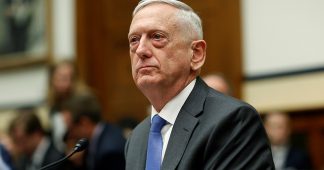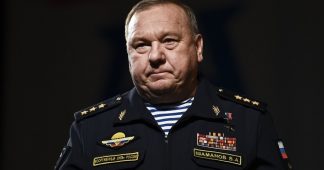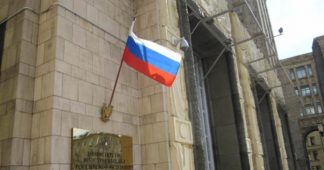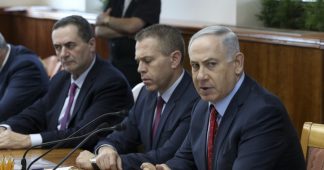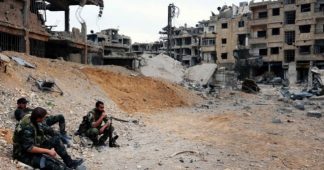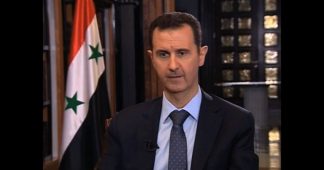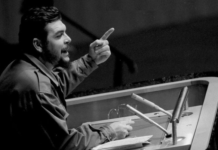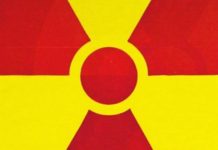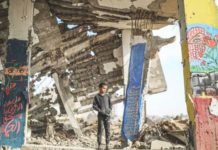By
April 14, 2018
Last Friday night, the United States launched a series of missile strikes on Syria in retaliation for the alleged chemical attacks by the Syrian army in Douma, a town in northeast suburb of Damascus. Douma, which is part of the Ghouta district where a ferocious war has been raging between the Syrian government forces and three major terrorist groups, has been completely encircled by the Syrian army. These strikes were, of course, totally illegal. Russia and the Syrian government have denied that there has even been a chemical attack in Douma, while in an interview with BBC Radio Scotland, Peter Ford, Britain’s former Ambassador to Syria said that he believes the chemical attack in Douma is staged. The Organization for the Prohibition of Chemical Weapons (OPCW) has announced that, on the invitation of the Syrian government, it will send a team to Douma to investigate the possible use of chemical weapons against civilians. But, President Trump and his national security team were not willing to wait until the results of OPCW investigations are reported.
Once again the mainstream media in the West, and in particular in the United States, are beating the war drums, as if they have learned nothing from their gross mistakes and misleading reports and “analyses” over the past 17 years, ever since the terrorist attacks on 11 September 2001. The allegation that the Syrian government has used chemical weapons in Douma is accepted uncritically and without a shadow of doubt. No one asks why the Syrian government, which is taking back most, if not all of Syria at a time when Trump has expressed his desire to pull U.S. troops out of Syria, should commit such a horrendous war crime. No one asks whether it would be the terrorist groups and their backers in Saudi Arabia, Qatar, United Arab Emirates, and even Israel, that would benefit from deepening of US involvement in Syria, or the Syrian government and its allies, Russia and Iran. If the attack was staged, who will benefit from it? Mainstream media almost never asks such critical questions.
While there is no doubt that chemical weapons have been used in Syria, killing a large number of innocent civilians, it is still not clear who the culprit has been. In fact, a review of credible reports and analyses by objective experts and journalists reveals that before Syria gave up its arsenal of chemical weapons in 2014, it was just as likely, if not more likely, that the opposition and terrorist groups used chemical weapons in the war, as the Syrian army. After Syria gave up its arsenal of chemical weapons, and particularly after Russia’s decisive intervention on behalf of Syrian government in 2015, it has become increasingly unlikely that the Syrian army would use chemical weapons against its own citizens. Let us take a look at the brief history of such allegations.
The first time it was alleged that the Syrian army had used chemical weapons against the opposition was on 17 October 2012, when France claimed that the town of Salqin in the governorate of Idlib had been attacked by such weapons. This was followed by allegations of attacks in Al-Bayadah in the governorate of Homs on 23 December 2012; in Darayya and Otaybah, both in the governorate of Rif Dimashq [Dimashq is the Arabic name for Damascus] on 13 and 14 of March 2013, and several others in April and May 2013.
On 6 May 2013 Carla Del Ponte, a former Swiss attorney-general, prosecutor with the International Criminal Tribunal for the former Yugoslavia, and a leading member of a United Nations appointed commission of inquiry about allegations of violations of human rights in Syria, stated in an interview that, based on the testimony of victims of such attacks, there were “strong, concrete suspicions but not yet incontrovertible proof” that “rebels” – the terrorists – in Syria had used sarin, a nerve agent, against civilians, adding, “I was a little bit stupefied by the first indications we got ….. They were about the use of nerve gas by the opposition.”
On 30 May 2013 Turkish authorities arrested 12 suspected terrorists in the southern provinces of Mersin, Adana and Hatay near the Syrian border. The suspects were carrying chemicals that could be used for making chemical weapons. In September 2013, Turkey put on trial a Syrian national who had attempted to procure chemical materials for two terrorist groups in Syria, the Al Nusra Front, the Syrian branch of al-Qaeda and the Ahrar al-Sham Brigades. The prosecutor filed a report stating that the accused, in collaboration with several others, had ordered 10 tons of sarin nerve gas in Turkey. Then, on 2 November 2013 Turkish patrol border units seized one ton of sulfur and eight sealed barrels from a convoy trying to illegally enter the country from Syria. Turkey’s main opposition party, Republican People’s Party, expressed concerns about such seizures.
Attacks with chemical weapons seemed to stop after Human Rights Watch reported one in Adra, in governorate of Rif Dimashq on 23 May 2013. But, they were resumed in Adra again on 5 August 2013. The United Nations decided to dispatch a group of experts to Syria to investigate the new attacks. The group arrived in Syria on 21 August 2013, exactly the day in which multiple chemical attacks occurred in Zamalka/Ein Tarma and in Muadamiyat al-Sham, both in the governorate of Rif Dimashq. Why would the Syrian government stage chemical attacks exactly on the day that the UN commission was arriving there? Once again, the mainstream media failed to ask such an obvious question.
Since the August 2013 attacks had supposedly crossed the “red lines” that had been set by President Obama, US attacks on Syria seemed imminent; but they did not occur. In an interview in April 2016 the President said that he did not order the attacks because James Clapper, then National Intelligence Director, told him that proving that the Syrian government was the culprit “was not a slam dunk.”
On 14 September 2013 Russia and USagreed to a deal according to which the Syrian government would give up its stockpile of chemical weapons for destruction. UN Security Council Resolution 2118 was passed unanimously on 27 September 2013 in support of the deal. The first load was delivered on 7 January 2014, while the last of such weapons were shipped out on 23 June 2014.
On 23 December 2013 eminent journalist Seymour Hersh reported that, “In the months before the attack, the American intelligence agencies produced a series of highly classified reports, culminating in a formal Operations Order – a planning document that precedes a ground invasion – citing evidence that the al-Nusra Front, a jihadi group affiliated with al-Qaida, had mastered the mechanics of creating sarin and was capable of manufacturing it in quantity. When the attack occurred al-Nusra should have been a suspect, but the administration cherry-picked intelligence to justify a strike against Assad.” Hersh’s report was practically banned in the United States.
After the chemical attacks on Ashrafiyat Sahnaya, a city in southern Syria, on 25 August 2013, such attacks stopped once again. They were resumed on 10 April 2014, and continued unabated through 30 August 2014. In an article on 17 April 2014 Hersh reported that “British intelligence had obtained a sample of sarin used in the 21 August [2013] attack and [its] analysis demonstrated that the gas used didn’t match the batches known to exist in the Syrian’s army chemical weapon arsenal.” Hersh also reported that a former US senior intelligence official told him, “We knew there were some in the Turkish government who believed they could get [Bashar al-] Assad’s nuts in a vice by dabbling with a sarin attack inside Syria….”
The chemical attacks began once again in the aforementioned town of Darayya on 15 February 2015. At that time Darayya was controlled by the Syrian Army. Why would the Army use chemical weapons in a town that it already controls? Such attacks continued until 21 August 2015 when the OPCW declared that Daesh [also known as ISIS or ISIL] had staged a chemical attacks in Mare’ in the governorate of Aleppo.
It was reported on 21 May 2015 that Turkish intelligence “helped deliver arms to parts of Syria under Islamist rebel control during late 2013 and early 2014, according to a prosecutor and court testimony from gendarmerie officers.” In October 2015 Hersh’s reports were confirmed. Eren Erdem and Ali Seker, two members of Turkish parliament, held a press conference in Istanbul in which they stated that they have wiretapped recordings and other evidence showing that Turkey supplied the sarin used in Syria. This was consistent with the aforementioned May 2015 report. Given that Turkey is a member of the NATO and a close ally of the United States, these credible reports should have attracted wide attention; but they did not.
A statement by the investigative team of the OPCW declared on 6 November 2015 with “the utmost confidence” that Daesh [ISIS] used sulfur mustard in an attack on 21 August 2015 in Mare’.
Foreign Policy reported on 16 February 2016 that Daesh had used mustard gas in Iraq in 2015.
Before the recent attacks in Douma, the last major attack happened in Khan Shaykhun in the Idlib governorate on 4 April 2017. Witnesses claimed that the attacks had used aerosol dispersion munitions that contained an organophosphate nerve agent. Officials of Syrian government vehemently denied the allegations, claiming that a Syrian missile had unintentionally struck a factory that was supposedly being used by the terrorists to manufacture chemical weapons. The Russian Defense Ministry stated a reason similar to that of the Syrian officials. The attacks prompted President Trump to order missile attacks on a Syrian air force base.
On 25 June 2017 Hersh presented sources and transcripts that indicated that there was no chemical weapons attack by the Syrian government in Khan Shaykhun. According to Hersh, the release of toxic chemicals stemmed from materials and munitions that had been stored in or near the designated target that was hit with a conventional bomb. Hersh’s article was not reported by any of the major US mainstream media.
From a human perspective it does not really matter who are the culprits behind these war crimes. A large number of innocent people, particularly children, have been killed. Needless to say, whoever has been involved in the chemical attacks has committed war crimes, and after the war in Syria ends, must be put on trial by the International Criminal Court. It is, however, important to remember, as Joe Biden revealed in a speech at Harvard University in October of 2014, that the US”allies” – Saudi Arabia, Qatar, United Arab Emirates and Turkey – internationalized the war Syria by supporting the terrorist groups in Syria; that secret e-mails by Hillary Clinton stated unequivocally that both Saudi Arabia and Qatar supported, and perhaps continue doing so, the jihadi groups in Syria; and that Turkey, a close US ally, most likely played a major role in spreading chemical weapons in Syria.
* Muhammad Sahimi is a professor at the University of Southern California in Los Angeles. For the past two decades he has published extensively on Iran’s political developments and its nuclear program. He was a founding lead political analyst for the website PBS/Frontline: Tehran Bureau, and has also published extensively in major websites and print media. He is also the editor and publisher of Iran News and Middle East Reports and produces a weekly commentary for broadcasting that can be watched at http://www.ifttv.com/muhammad-sahimi.
